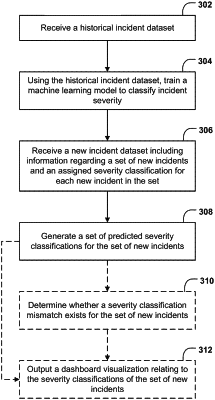| CPC H04L 41/0609 (2013.01) [G06N 3/04 (2013.01); G06N 7/01 (2023.01); G06N 20/00 (2019.01); G06N 20/20 (2019.01); H04L 41/16 (2013.01)] | 20 Claims |

|
1. A method for automating incident severity classification, the method comprising:
receiving, by communications circuitry, a historical incident dataset, the historical incident dataset including information regarding a set of historical incidents and an assigned severity classification for each historical incident in the set of historical incidents;
receiving, by the communications circuitry, a new incident dataset, the new incident dataset including information regarding a set of new incidents and the assigned severity classification for each new incident in the set of new incidents;
cleansing, by a model generator, the historical incident dataset by removing one or more predetermined ancillary and irrelevant data from the historical incident dataset to prevent overfitting of the historical incident dataset and by scaling values within the historical incident dataset to a predetermined standard scale;
after cleansing the historical incident dataset, generating, by a prediction engine, a set of predicted severity classifications for the set of new incidents using a machine learning model, the historical incident dataset, and the new incident dataset;
determining, by comparator circuitry, that a severity classification mismatch between at least one assigned severity classification and a predicted severity classification of the set of predicted severity classifications exists for the new incident dataset; and
in response to the comparator circuitry determining that the severity classification mismatch exists, prompting further investigation of the severity classification mismatch, by the communications circuitry, through outputting an indication of the severity classification mismatch.
|